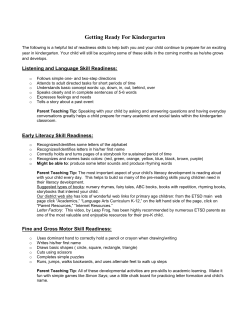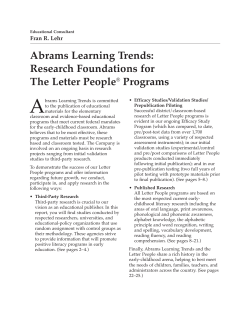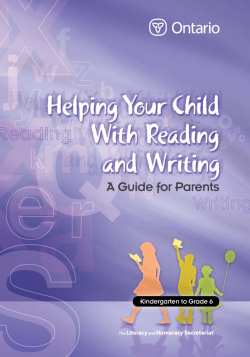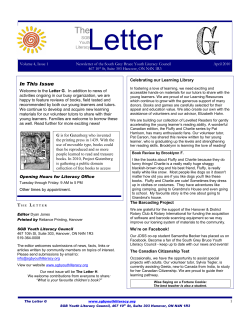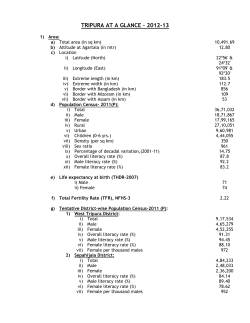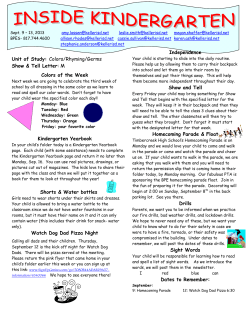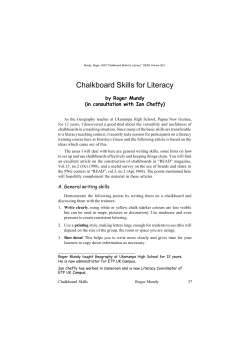
Document 28363
Writing to Read in Kindergarten: Explore the Power of “Kid Writing” A Complementary Seminar Sampler (e-Book) from Julie Lay and Nellie Edge Table of Contents 1. Rituals That Build Our Learning Community 2. A Circle of Respect 3. “Midge” The Hedgehog 4. Management and Planning Essentials For Literacy Environments 5. Keep Books Accessible 6. Name Word Walls Help Us Write About Our Friends 7. Teaching The Concept of “Word” 8. Fun With “THE” 9. “By Heart” Word Walls Features Only High-Frequency Words 10. Write The Room 11. Block Building and Kid Writing Go Together 12. Kinders Make “Skinny Books” Using Word Stamps 13. Our Study of Leaves 14. Spring Smiles on Us With Weather Similes 15. Bird Projects: Combine Art, Writing and Joyful Learning 16. Alias Letter “Y” 17. Where Do People Read and Why Do People Read? 18. Read Together Notebooks Support Emergent Readers 19. We Connect Oral Language to Print: I Like Stars 20. Book Boxes Encourage Independent Reading 21. Teaching Comprehension Through Schema 22. Build Comprehension and Vocabulary Through Word Work 23. Teaching Comprehension: Use Mind Pictures and Questioning Strategies 24. The Center of Our Classroom is a Library 25. Student-Led Conferences 26. About Julie Lay 27. About Nellie Edge 28. Julie Lay’s Writing Resources: Where To Get Them 29. Julie Lay’s Writing Resources Continued 30. Writing to Read in Kindergarten: Our Valued Resource Books An invitation to study “Kid Writing” with Julie Lay Promoting Excellence in Kindergarten Literacy www.nellieedge.com ©2008 Rituals That Build Our Learning Community… “The Lighting Circle” “The Lighting Circle” is a much-anticipated ritual conducted twice a week. On Monday, children enter the room with the main lights turned off. As they quickly put backpacks and coats away, they are already thinking about what they will share about their weekend. After everyone is seated quietly in a circle, the candle is lit. I focus them further by saying, “Think about what you did, places you went or people you saw this weekend...when you have your idea in your head, put your thumb up to let us know you‟re ready.” „Red‟, our class-sharing hedgehog, is passed from child to child as they share a highlight or thought from their weekend. After sharing, we announce our learning circle is open for the upcoming week and a child blows out the candle. This process is repeated on Friday just before the children are dismissed. However, this time the children share a highlight or something they learned at school during the week. After everyone has had a turn, we announce our learning circle is now closed for the week and a child blows out the candle. Credit for this idea is given to Andie Cunningham and Ruth Shagoury in the their book, Starting With Comprehension: Reading Strategies for the Youngest Learners, Stenhouse, 2005. 1 A Circle of Respect... Our Promises To One Another Having the children write their own promises (rules) for each other helps establish a community of learners who work together better than a dictated list of rules that the teacher makes arbitrarily. In a child’s mind, a rule can be broken, but a promise must be kept. The kids generate their own list (usually longer than I would do) and I act as their scribe to put their words on paper. And yes, it is okay to keep adding or changing them as the year progresses! After agreeing to the promises, the kids must come up with a reasonable consequence for broken promises. This is also written on the circle of respect promise board. After coming up with a list, children then sign their names around the edge of the circle pledging their allegiance to their promises. They are also issued a clothespin with their name on it which is then clipped to the outside edge of the circle. If someone breaks a promise, they are asked to move their clip from our ‘Circle of Respect’ to another location (simply a yellow paper hanging on the wall under the promise circle) and follow the consequence listed. Children earn back their spot in the circle by demonstrating to their classmates that they can follow the formally broken promise. This places more responsibility on the children, rather than an authoritarian figure. Credit for this idea given to Andie Cunningham and Ruth Shagoury in their book, Starting With Comprehension: Reading Strategies for the Youngest Learners, Stenhouse, 2005. 2 “Midge” The Hedgehog Our Class Pet Our class mascot is a Hedgehog. We actually do have a real hedgehog pet and her name is “Midge.” Having a live animal to care for makes a great learning experience for kids— especially one that is rather unusual. Having a pet hedgehog also invites children to learn about their care, babies, and different types of hedgehogs. Providing resource books from pet stores about hedgehogs gives the children an opportunity to read or want to read about hedgehog care. Having a live pet also provides opportunity for drawing and life lessons about what happens when a pet dies. One of our pet hedgehogs died two years ago and that gave us an opportunity to draw and write about our beloved pet. We wrote an entire book about our pet “Miss Prickles.” Here are some examples of the children’s drawings: 3 Management & Planning Essentials For Literacy Environments Creating a literacy environment takes some careful thought, planning and bargain hunting. Exemplary learning environments weave together the right amount of color, light, sound and smells to create a home-like atmosphere. Color: Light blues and greens are the predominate color scheme in the classroom. Accenting with yellows, reds, and oranges creates the right balance for exceptional learning. Blues and greens are purposefully chosen because of their calming effect on behavior. Light: Outside lighting is by far the best, however many classrooms have limited windows. You can eliminate some of the flickering effect from fluorescent lights by strategically placing incandescent lamps to create a home-like feel. Remember the fire marshal’s rules about the use of extension cords and use a maximum of 60-watt bulbs when planning your room’s layout. Sound: Music plays an important role in the classroom feel beyond its use for singing or dancing. Try using “relaxation” music CDs during work time. Remember to play them softly enough so as not to disrupt work, yet loud enough to be heard. You can also use small water fountains or bubblers as an accent for relaxation. The addition of recycled tennis balls on the bottoms of chairs not only helps in noise reduction, but the custodians sing our praises for not having to rewax the floor mid-year! 4 Keep Books Accessible: Invite Children to Read Rain gutters create an excellent way to display books so that the covers are visible. These are inexpensive and are easily installed under windows, chalkboards or bulletin boards and enhance the literacy “feel” of the room. Keep in mind, as you build your class library, that students do not naturally select leveled readers or highly structured reading collections. Phonics readers are another group of books that do not command the attention of students. Children love real books. Don’t forget about the Big Books in your classroom library. Here is a great way to store them: a cardboard box covered with contact paper. Add cardboard dividers. 5 Name Word Walls Help Us Write About Our Friends A useful and meaningful “first-word wall” for children will feature their names. An alphabetical chart kept in the meeting area becomes a helpful reference during group lessons. Color-matched beginning letters can easily be seen for discussion. I take a close-up photo of each child on the first day of school and mount it on a 3"X 5" index card along with their name. Children can remove the names any time during the day to copy. The flexibility of a small pocket chart for this word wall makes it easier to add or delete names as the year progresses. Family Name Wall Kinders often want to use family member’s names like “Grandpa Joe” or “Aunt Sue” in their writing. It is helpful to generate a small word wall (in chart form) to have for children to reference. Some teachers ask children to draw a picture and label the names of all the people and animals in their family. They keep this reference in their writing folder. 6 Teaching The Concept Of “Word” Many children enter kindergarten not knowing what a word is, or the difference between letters and words. Teachers can use pocket chart strategies to help children pay focused attention to how words and sentence syntax works. Sentence strips are cut apart into individual words for ease of manipulating and highlighting text and for ease of storage. Key words are highlighted with colored acetate overlays. This helps even the emergent reader begin to internalize and „visualize‟ the concept of word. Where to store long sentence strips is often a concern for teachers. By cutting apart sentence strips into individual words, you have an easy storage solution. Leaving spaces between individual words (as shown below) makes it easier for emergent readers to grasp the “concept of word”. In the pocket chart photo below, children can easily “see” and manipulate individual words. Color Overlays Highlight HighFrequency (“By Heart”) Words The colored words are merely cutto-size acetate paper (from report covers). On previous lessons, students were locating „by heart‟ words and marking them with the acetate color overlays. Children enjoy finding all the words they know “by heart.” You can purchase pre-made pocket chart highlighter strips from www.abcstuff.com (item number HT010). 7 Fun With “THE” The little word “the” is not an exciting, emotionally appealing word all by itself, yet it is a high-frequency word young readers will need automatic mastery of early on. Wise, imaginative teachers of young children understand how to use the power of movement, rhythm and rhyme to create memory hooks for word study. They recognize children are first auditory spellers and they want all children to engage in joyful, satisfying literacy events. Consider the following explicit multisensory teaching: “You Can Say „the‟ chant… a jivy chant that demonstrates the two pronunciations of “the” in a rhythmic spelling way. Start by setting up a strong, 3-beat rhythm (stomp stomp clap, stomp stomp clap) while chanting… You can say the, You can say thee, But it’s always spelled T-H-E ! After learning the chant, kids make their first “By-Heart” word necklace to take home and show off. This will be the first word to appear on the “By-Heart” word wall in the classroom. “The End” is a meaningful and useful phrase. Our Read and Sing Big Books and Little Books all end with the words: “The End.” We want children to confidently anticipate chanting and reading those last two words. To emphasize these words, I teach children to carefully articulate and recite in a 3-beat rhythm: “T-H-E E-N-D, The End!” Children quickly come to recognize the letters and words. Many will write “The End” independently on their own Little Books and writing projects all year long. The repetition builds instant word recognition. Julie Lay’s kindergartners enjoy a “T-H-E E-N-D The End—Do it again!” spelling chant by standing up and swinging their hips and arms to a “Cha-cha-cha” rhythm to celebrate the last page of their Nellie Edge Read and Sing Big Books. Special thanks to Jennifer Foster for the “THE” chant! 8 “By Heart” Word Wall Features Only High- Frequency Words The main word wall in the room should only focus on highfrequency words. By focusing on only these high utility words, space is maximized for environmental or theme related print in other locations in the room while minimizing the space needed for one permanent word wall. Resist the temptation to display children’s names on this board. Some teachers call high-frequency words “Star Words” because the words are ‘special’ like stars. Others call them “Popcorn Words” because they are always ‘popping up.’ I prefer the term “By Heart Words” because the children need to know these words ‘by heart.’ Fingerspelling To help make connections between a written letter and its corresponding sign, I have combined two different alphabets: the heart alphabet and the sign language alphabet. These are displayed at the children’s height so the large sign language hand shapes are easy for them to form. Children practice by holding their hand on top of the picture. The Sign Language Alphabet Line by TS Denison is available at www.frankshafferpublications.com High-Frequency (“By Heart”) Words That Kindergartners Actually Write and Read *These 52 words comprise more than 50% of the actual words young children initially write and read. I me/we/be is/it and book dear for with girl love the cat go/no look today was his boy you see dog stop to he/she are her today Mom a/A like yes from get on they said Dad this can my/by have thank am at/as in An ongoing fluency action-research project, with Nellie Edge and colleagues 2008-2009. 9 Write The Room: Good Practice For All Write The Room is a popular choice time activity. With a little “tweak” later in the year, it can become part of a writing/reading time “word work” assignment. At the beginning of the year, kids are given a blank paper on a clipboard, which they carry around the room and just copy print. Next they are given a template page and the directions to find certain alphabet letters around the room. They record the words in which the target letter is found. Sometimes, I may give them a template page which spells a word, such as “December.” (See student example below.) In the spring, you may give them a “word work” template in which they are to find certain blends, diagraphs, etc. within words. Examples might include: Finding words that contain “th” “ea” or “ing”. Write The Room Fun! Write The Room using Sign Language Dictionary 10 Block Building and Kid Writing Go Together The block center is a well-loved activity of choice in our room. Children build castles and cities and have even spelled words using the blocks. Today this fine group of builders has created a road through a city and written the sign “Do not knock the castle down” to remind their friends to be careful. Other common “kid writing” signs in my classroom include “Do not touch” and “Do not enter.” Remember when planning the set up of your classroom that the block area can double as another usable space. Here a simple wooden storage box (purchased at Target) contains all the blocks when they are not in use. During independent reading time this space is used to sit on and read. 11 Kinders Make “Skinny Books” Using Word Stamps Making stamp and read “Skinny Books” is another active way to teach the concept of word. Children can kinesthetically feel each word as they stamp it. The “skinny books” are mass created by parents—they are simply 4 sheets of paper cut into strips and stapled together. The limited number of word stamps* (I, see, the…) and the thin design of the book pages supports the child in creating one sentence on each length of paper. Stamping naturally leaves a space between individual words so that children can more clearly see the definition of each high-frequency word. Children add their own drawing (with or without a word) to finish their sentence. Kinders take pride in these books, which they can read on their own, share with a friend, or read to the class. They happily take these books home because children can read “skinny books” featuring repetitive patterns. *High-frequency word stamps are available from Nellie Edge Resources, Inc. (see list of writing resources). 12 Our Study of Leaves Gathering and studying leaves engages our kindergarten scientists and connects them with nature. There are so many different types of leaves to look at closely with a magnifying glass – and the colors they come in are as infinite as the colors in a rainbow. My students really ‘get into’ collecting leaves at home – and school. We have discovered it is easy to keep leaves fresh by putting them into gallon ziplock bags with a damp paper towel. You can keep leaves for up to a month this way, sealed in the refrigerator without having their brilliant colors fade. “One by one the leaves fall down…” and by late October we begin collecting and comparing them. It is amazing to see how naturally writing is produced after meaningful investigation and real hands-on activities. Here is one sample of a child’s ‘leaf research.’ Each child chose a particular leaf to learn more about. Leaves Fall Down One by one the leaves fall down From the sky come falling one by one And leaf by leaf the summer is done One by one by one by one. by Margaret Wise Brown Download a copy of this and other poems with enlarged print for your “Read Together Notebook” or “Poetry Notebook” at www.nellieedge.com/whatsnew.htm#4. 136 13 Spring Smiles on Us with Weather Similes “In just spring… when the world is puddle wonderful,”* we study the weather. We also think about how similes about the weather make our writing more interesting. The following two samples are examples of what our young writers are capable of when their creative juices are allowed to flow. A rainbow is as colorful as a box of crayons. A tornado is as swirly as a slinky. Enjoy the Poetry of Weather Whatever the Weather Whether the weather be fine Or whether the weather be not, Whether the weather be cold Or whether the weather be hot, We’ll weather the weather Whatever the weather, Whether we like it or not. ~Traditional *Enjoy In Just by E.E. Cummings Listen to the beautiful imagery in poetry: “The Earth is Like a Butterfly…” from Easter, by Joyce Kilmer “White Sheep, White Sheep On A Blue Hill…” from Clouds, by Christina Rosetti Adapted from Celebrate Language and Accelerate Literacy: High Expectations • Joyful Learning • Proven Strategies by Nellie Edge ©2008. (Publisher to be announced) For free “I Can Read” Poetry pages see www.nellieedge.com/whatsnew.htm#4. 14 Bird Projects: Combine Art, Writing and Joyful Learning We developed a whole new appreciation for birds as we tried our best to build nests. As with all of our projects, writing was a big part of the finished product. Children made signs: Konnor’s Nest, Just Look Don’t Touch, Just Look. Maddie One year, we had ‘feathery’ fun by making our own bird masks with paper plates, construction paper and lots of interesting and colorful feathers. Afterward, we paraded around to different rooms and the office singing like birds! 15 Alias Letter “Y”: Exceptionally Fun Word Work! Through many of our classroom reading and writing experiences, the children begin to understand and learn about one particular letter of the alphabet that likes going „under-cover‟ and playing tricks—the letter “Y.” Letter „y‟ wants to become a vowel SO BAD, that he usually plays tricks—especially on the ends of words. On this particular day, the children used books from their reading book boxes, grabbed some post-it notes and a word whacker and went to work locating letter „y‟ at the ends of words. They quickly jot down their word, display it on the chart in the circle area and go to work finding more. At the end of work time, the chart paper is brimming with all of their “finds.” By the following day, I had transferred all of their ideas to index cards which had been cut in half. The children sat in a circle as the cards were given out and worked together to read their alias „y‟ word. We carefully listened to the vowel sound each „y‟ was imitating and divided our words into categories. Children are wonderful “Word Detectives!” 16 Where Do People Read and Why Do People Read? We want children to see themselves as readers. When children investigate where and why people read they see reading as an important real-world activity. Kindergartners can begin thinking about their own reading habits and preferences: “I love books about cats.” Children spend a great deal of time interacting with wonderful and informative books within the classroom. They continue noticing the reading lives of significant adults and siblings in their lives. These positive associations begin developing a lifelong love of reading: “Reading is important to people I love.” 17 Read Together Notebooks Support Emergent Readers No matter what you call them – “Read Together Notebooks,” “I Can Read Notebooks,” “Poetry Anthologies,” etc. – a collection of simple familiar songs, poems, and rhymes is an important part of the kindergarten reading program. At the beginning of the year, notebooks are kept in tubs by color group to ease the process of finding and putting away. By about midyear, the notebooks are kept in the children’s individual book boxes for independent reading time. In the back of each child’s Read Together Notebook is a zipper pouch. This is where the students keep copies of their mini books for use during independent or “buddy reading” time. For a detailed photo essay on How to Develop Read Together (or Poetry) Notebooks, to download free little books and copyright-secured poetry pages, see www.nellieedge.com. 18 Connect Oral Language to Print with Poems, Songs and Rhymes Each new pocket chart rhyme goes into the child’s “I Can Read” or “Read Together” Notebook for fluency practice. Familiar language patterns often also inspire “Kid Writing”. I Like Stars Blue stars, Red stars, Green stars, too. I like purple stars. How about you? Orange stars, Pink stars, Yellow stars, too. I like rainbow stars. How about you? Pamela Johnson Download I Like Stars and over100 other copyright-secured songs, poems and rhymes at www.nellieedge.com. 19 Book Boxes Encourage Independent Reading On Mondays, all of our kinder friends go “shopping” for 5 new books to fill up their book boxes. At least two of their selections need to be „just-right‟ (books they can truly read and have read during small group instruction). The other three can be „challenge‟ books (text that is above their reading ability, but they can read the pictures). Time is given each day to read independently or with a buddy. Children find cozy reading places around the room – even under tables! Book box reading begins in February with the children immersed in books for about 10 minutes. By late spring, children are spending almost 20 minutes daily in independent reading and extension activities or comprehension strategy instruction. Reading expands with “word work.” Some days, as part of independent reading, we extend the activity and work with concepts or strategies (schema, mind pictures, etc.) or we do “word work.” The boys pictured below are using „literacy frames‟ to find words from books that have –ing in them. They place post-it notes wherever they come to an –ing word. At the end of the page, they write down the words they found and pull off the post-it before moving on to the next page. 20 Teaching Comprehension Through Schema Reading workshop has taken on a new life in our classroom through a melding of concept teaching from Debbie Miller’s Reading with Meaning, Linda Hoyt’s Spotlight on Comprehension, and Andie Cunningham’s Starting with Comprehension. Helping children connect literature first to their own life experiences, then to their knowledge of the world around them, and finally to other literature, builds comprehension and helps children read for meaning – right from the start. Bringing Schema to Vocabulary Development At the conclusion of reading workshop, we gather together to recap the strategy focus. Today’s focus was on finding ‘interesting words.’ One word chosen and recorded by a student was ‘snaking.’ To help bring schema and dramatics into comprehension, everyone got on the floor and acted out and it looks and feels to be ‘snaking.’ Kinesthetic Learning Builds Comprehension Movement, drama, dance and simulation activities create the internal kinesthetic knowledge that bridges feeling with comprehension of language concepts and new vocabulary. Children love comprehension activities and parents are amazed at their child’s vocabulary and thinking skills. The children are excited about the comprehension strategies. You often hear a child say, “I’m using my schema.” They are so proud of themselves… Parents are just amazed because this is a new learning experience for them too. We often include in our parent letters home the definitions of the vocabulary used for developing these comprehension strategies. 21 Build Comprehension and Vocabulary Through Word Work: Science Studies Inspire Deep Thinking, “Kid Writing” and Detailed Drawing Comprehension through “word work” became one of the most favorite extension activities during reading workshop. For some children, I suppose it may have been the novel experience of using post-it notes. But for many other students, there was genuine excitement in being able to „think‟ on their own and really „listen‟ to others‟ thinking. My kinders realized that “word work” leads to a deeper comprehension. At the beginning of a unit on butterflies, and later one on bees, I posed the question, “What do you wonder about…?” The children eagerly took their post-it and went off by themselves or with a partner to draw and write their question. What do you wonder about bees? How do yellow jackets get their stinger? How do they get all of their colors? What kind of food is your favorite? How do bumble bees make their poison? Asking questions is a powerful strategy for building comprehension: What? Where? When? Why? How? 22 Teaching Comprehension: Use Mind Pictures and Questioning Strategies Creating mental images and asking questions are powerful strategies for building comprehension. By creating pictures in their mind, children begin to „see‟ with new eyes – within their mind and other‟s too! Another helpful strategy is to know “how” to ask the right type of questions to better comprehend a text. We begin our study with reading The Grouchy Ladybug by Eric Carle. On chart paper, I have drawn a picture of the grouchy ladybug. Now I pose the question, “What made the ladybug so grouchy?” Children illustrate and dictate their response. Because somebody teased him. He wanted someone to fight. Not enough sleep. Wife woke him up too early. One focus lesson was to research information about ladybugs and come up with their own question. Children illustrate and write their questions onto post-it notes. We discuss and categorize their questions. Discussion often leads to even more questions that children think are important to ask! Do aphids taste bad? I wonder if ladybugs chew? How many spots do they have? 23 The Center of Our Classroom Is A Library Central to your room should be a classroom library. In our room, the library is located on shelves, like these shown, with books sorted by theme into tubs. Labels are made and taped onto the front of the tubs for easy access. Matching labels are put onto the front of each book in the tub for resorting ease. “The library needs to be the most enticing area of the room.” - Regie Routman Labels Tip: Use Avery 8160 labels and print 3 pictures per label, then cut them apart to attach to the books. I use PrintMaster Platinum #12 by Broderbund for the clipart. My goal was to transform my room from a classroom with a library in it to a library with a classroom in it. The most effective reading programs are generally supported by large classroom libraries. The better the libraries, the better the reading achievement as measured on standardized tests. An adequate classroom library will have at least two hundred books, but an excellent library will have more than a thousand. Keep in mind that most children naturally prefer non-fiction and “animal” titles. Nonfiction reading leads to more informational writing, which is related to higher reading achievement scores. 24 Student-Led Conferences: A Child’s Showcase Student-led conferences are a very powerful and exciting way to present progress to the parents. In kindergarten, conducting student-led conferences near the end of the year works well. Students are more confident and comfortable with the format of being the „presenter‟ and are more able to present the information with ease. The format of shared items is easily presented using a student “portfolio.” Work gathered throughout the year, is assembled into a 3-ring notebook and grouped according to reading, writing, math and science. Shown are the front and back views of an actual portfolio. Shown below is the inside view of a portfolio. Opening the cover, you‟ll find report cards or assessments, published books, star charts, behavior clips and an end-of-the year book called „Farewell Kindergarten.‟ The literacy pocket also sports some photographs of the child in action. The same follows suit for other pockets. Next, items that are too large to fit comfortably in the pockets are hole-punched and inserted into the binder. The child‟s Star Word book and journal pocket with the journals are tucked inside last. Parents are extremely happy with this type of portfolio as it is easy to keep on bookshelves and resembles “baby books” they already have stored at home. 25 About Julie Lay Julie Lay is an experienced teacher who has taught over a span of K-8th grades over the past 26 years. Most of her practice and her passion has been in kindergarten. Julie is a teacher, researcher and a member of the Three Sisters Reading Council. She is a teacher trainer for the Redmond School District and continues to lead workshops in the area of reading and writing along with also being one of the literacy specialists in her district. Julie has received numerous teaching awards including the Outstanding Literacy Award from her district in 2004 and the Nellie Edge Excellence In Kindergarten Literacy Award in 2003. Most recently, Julie earned National Board Certification for Literacy/Language Arts in Early-Middle Childhood in November 2004. She is currently working on her Masters in Reading and Literacy from Walden University. Julie believes, and demonstrated, that young children learn to read by first learning to write. She successfully implemented a grant funded by The Family Ford Foundation, which was dubbed “Dancing Pencils.” This grant helped develop a writing continuum and provide quality staff development in writing for grades K-5. Julie has long been an advocate of using brain-compatible practices for young children. She combines a strong mix of music, movement, drama, art, and sign language infused with developmentally appropriate practice in her teaching style. Julie’s room is alive with engaging and meaningful learning and is comfortable yet stimulating to visit. She uses thoughtful consideration of color, lighting and sound to create an atmosphere conducive to learning. Julie’s future plans include developing and implementing a “Literacy Magnet” within her school, which would include a full-day kindergarten model. Through the use of best teaching practices and thorough knowledge of how children learn best, Julie continues her journey as a student of learning committed to making a difference in the lives of children. Julie’s husband, Steve, is also a teacher. They live at Smith Rock State Park in Terrebonne, Oregon. Their son Micah is in high school and their daughter Heather is attending Western Oregon University to become an elementary teacher. As a close family unit they enjoy traveling abroad, church involvement, birding and – of course – reading and writing. 26 About Nellie Edge Nellie Edge is a kindergarten teacher-researcher, literacy coach, nationally recognized early literacy trainer, storyteller, musician, and recording artist. While teaching in a bilingual kindergarten in Albuquerque, New Mexico, she discovered the power of developing language and literacy skills through traditional Spanish and English folk songs. Her desire to make learning to read successful and joyful for all children led to the publication of her Nellie Edge Read and Sing Big Books™, with Parents as Partners and Brain-Friendly Literacy™ guides. Nellie Edge’s commitment to children’s literacy is evident in her Excellence in Kindergarten and Early Literacy website. A recipient of the IRA Reading Excellence Through the Arts award, Nellie Edge is a proponent of using sign language and all of the arts to enhance early literacy skills. She is the founder of the Northwest Coalition for Excellence in Kindergarten Literacy and a strong advocate for developing training and support systems for teachers that demonstrate exemplary practices and honor the rightful needs of childhood. Nellie Edge is the author of numerous poetry anthologies, early childhood texts, teaching videos, audio recordings, and excellence in kindergarten and early literacy resource books. Her resource materials and training provide a vision of optimal literacy instruction within a joyful community of learners. She skillfully articulates scientifically based research and wisdom of practice with multisensory, emotionally engaging strategies that accelerate literacy skills while keeping the love of language alive. Nellie Edge literacy resources, seminars and keynote presentations have inspired thousands of educators throughout the country to accelerate language and literacy learning by taking advantage of how the brain learns best. Kindergarten is for Language “It is the familiarity with the English language that allows a child to develop phonemic awareness, build comprehension and extend vocabulary. It is the familiarity with the English language that allows a child’s decoding to be error free and reading to be fluent. Oral language is the vital foundation that allows us to “Put Reading First” and develop ambitious, thoughtful readers and writers. We teach most powerfully when we celebrate language, involve parents, and honor childhood.” Nellie Edge 27 Julie Lay’s Writing Resources: Where To Get Them ABC Beads: Wal-Mart, Dollar Store, and Michael’s Craft Stores Alphabet Stamps: (Transparent) Really Good Stuff, 1-800-366-1920 or www.reallygoodstuff.com Clip Art Computer Program: (“Print Master”) Staples Date Stamps: Wal-mart, Staples, Office Max, and other office supply stores File Jackets: (non-expanding for writing folders) Staples and Office Max Finger/Hand Pointer Sticks: Teaching Resource Center, 1-800-833-8552 or www.trcabc.com. Also make your own with dowel rods and embellishments found at Michael’s Craft Store, Party Depot or children’s toy stores. High-Frequency Word Stamps: (for making “Skinny Books”) Durable, hardwood stamps in a set of 6: “I, see, a, this, is, the.” 30 Word sets also available. (These Literacy Sets developed by Nellie Edge, will be available under a new publisher in 2009. For more information contact 1-503-399-0040 or see www.nellieedge.com) Highlighter Tape: Really Good Stuff, 1-800-366-1920 or www.reallygoodstuff.com Letter Tiles/Unifix Cube Blends/Onsets & Rimes: Really Good Stuff, 1-800-366-1920 or www.reallygoodstuff.com Magnetic Plastic Letters: Blue Consonants/Red Vowels in correct print. Teaching Resource Center, 1-800-833-8552 or www.trcabc.com Magnetic Letter Storage Boxes: Wal-Mart (fishing tackle boxes) or at Teaching Resource Center, 1-800-833-8552 or www.trcabc.com Non-Skid Grip Liner: (for trays or math mats) houseware department of stores ‘Oops’ Tape: (Post-It 6-line Correction & Cover Up Tape 1" x 700") Staples, Office Max and www.schoolspecialty.com 28 Julie Lay’s Writing Resources Continued Pocket Charts: Teaching Resource Center, 1-800-833-8552 or www.trcabc.com . The original McCracken Pocket Charts are available at School Art Materials, Box 45162, Seattle, WA 98145 or 1-206-526-0775 Pocket Chart Highlighter: (colored acetate) use “report covers” from Wal-Mart, Staples, Office Max, or any office supply store Poems, Songs & Rhymes: (for Anthologies) Over 100 free copyright secured pages at www.nellieedge.com or 1-503-399-0040. Additional “Small Poems of Some Delight” and other classic childhood poems available as compilations. Plastic Serving Trays: (for focused work areas) restaurant supply stores Practice Golf Balls: (hollow with holes for pencil grips) sporting goods department of stores Sign Holders: (5" x 7" for table-top alphabet charts) Staples and Office Max Space Man: (for practicing leaving spaces between words) Really Good Stuff, 1-800-366-1920 or www.reallygoodstuff.com Tennis Balls: (for chair legs) Recycled balls from tennis courts, or Really Good Stuff, 1-800366-1920 www.reallygoodstuff.com White/Dry Erase Boards: “Shower Board” from Home Depot or Lowes. Comes in a large (4’ x 8’) sheet. Occasionally (if asked) the store may cut it for you. I prefer mine to be cut into 6" x 9" boards, for individual use. Custom-made boards can be purchased through Really Good Stuff, 1-800-366-1920 or www.reallygoodstuff.com Wikki Sticks: Crystal Springs Books, 1-800-321-0401 or www.crystalsprings.com Word Whackers: Crystal Springs Books, 1-800-321-0401 or www.crystalsprings.com Videos: Bureau of Educational Resources www.ber.org or 1-800-735-3503 “Using Modeled Writing”, and “Using State-of-the-Art Strategies for Teaching Writing” with Oregon kindergarten teacher Darla Wood-Walters “Using Interactive Writing” with Judy Lynch 29 This Complementary Seminar Sampler is from the Writing to Read in Kindergarten: Explore the Power of “Kid Writing” seminar literacy manual, with award winning kindergarten teacher and literacy coach Julie Lay, NBCT. See Current Seminar Information and Registration at www.nellieedge.com Plan ahead for summer: Join us in July, 2010, for Writing to Read in Kindergarten: Explore the Power of “Kid Writing” and our other Joyful Accelerated Literacy Seminars in Salem, Oregon. • Each seminar is limited to 75 participants. • Registrations accepted in January, 2010. Enjoy Video Clips of “Kid Writing” Workshops with Julie Lay at http://www.nellieedge.com/movie_kidwriting.htm. Writing to Read in Kindergarten: Explore the Power of “Kid Writing” manual by Julie Lay and Nellie Edge is now available from our online bookstore. Consider bringing this seminar to your district, E.S.D., or State Kindergarten Conference. Ask your literacy coordinators to contact us. (Allow 3 to 4 months planning) Please e-mail info@nellieedge.com for information. We invite you to share this complementary Writing Seminar Sampler and our other free eBooks with your kindergarten colleagues, principal, parents, and literacy support staff. Create a joyful Writing to Read classroom. You will be amazed at how quickly your children move from “Kid Writing” to Independent Writing and Reading. Mrs. Lay Hi. This is Brady. I Here is a spontaneous letter from found you a new Brady to Mrs. Lay: friend. His name is Prickles. Brady Barnes Untitled:Users:pattisohn:Desktop:ne2:ebook-update-writingRead:Seminar information.doc Writing to Read in Kindergarten: Our Valued Resource Books Happy “Kid Writing” from Nellie Edge and Julie Lay Developing a passion for writing is the key to higher literacy standards in kindergarten. Daily “kid writing” is how we systematically teach and reinforce phonics skills in actual practice. “Kid writing” gives children authentic motivation to want to write letters and words with increasing accuracy. This writing is enhanced by the skilled use of modeled and interactive writing. Kindergarten teachers have loved using the book Kid Writing: A Systematic Approach to Phonics, Journals, and Writing Workshop. Teachers describe “kid writing” as the systematic piece that enhances the New Zealand process writing model. We highly recommend this important and award-winning book. Kid Writing: A Systematic Approach to Phonics, Journals, and Writing Workshop. Eileen Feldgus and Isabell Cardonick. The Wright Group, 1999. See www.kidwriting.com to view the original “Kid Writing” classroom and order the book. The book is only available through this website. How do you use interactive and modeled writing to teach skills and engage children in meaningful writing throughout the curriculum? All Kindergarten Children Love to Write shows how mentor kindergarten teachers support young writers. This inspiring book demonstrates writing strategies across a meaning-centered curriculum. All Kindergarten Children Love to Write. Jennifer Foster, Jeff James, and Nellie Edge. Nellie Edge Resources, updated 2005. (Full-color seminar resource manual only available through the training program or on loan from Salem-Keizer School District, Salem, Oregon.) Download complementary 30-page e-Book, Joyful Writing-to-Read Kindergartens, featuring many excerpts from the above literacy manual at www.nellieedge.com/whatsnew. See also: Photo Essays: Writing-to-Read and articles/All Kindergarteners Love to Write at www.nellieedge.com Innovative kindergarten teacher, Julie Lay, in study and collaboration with Nellie Edge has built on the original Kid Writing book and study with Eileen Felgus to develop a joyful, meaning-centered kindergarten where children learn to read by writing. She shows how to systematically organize to accelerate literacy and engage children in writing across the curriculum. Writing to Read in Kindergarten: Explore the Power of “Kid Writing”. Julie Lay and Nellie Edge. Nellie Edge Resources, Inc. 2006, updated 2008. Our Other Valued Resources: Units of Study for Primary Writing: A Yearlong Curriculum. Lucy Calkins, The Teachers College Reading and Writing Project, Heinemann, 2003. (The “Kid Writing” approach provides a natural transition into these units of study.) About the Authors: Writing Workshop With Our Youngest Writers, by Katie Wood Ray. Heinemann, 2004. Start With Comprehension: Reading Strategies for the Youngest Learners, by Andie Cunningham and Ruth Shagoury. Stenhouse, 2005. “The Teaching Behind About The Authors: How To Support Our Youngest Writers” (DVD) by Katie Wood Ray and Lisa B. Cleaveland. Heinemann, 2006. “Using Modeled Writing” and “Using State-of-the-Art Strategies for Teaching Writing” (Videos) with Oregon Kindergarten teacher Darla Wood-Walters, Bureau of Educational Resources, 1998. 30
© Copyright 2025

